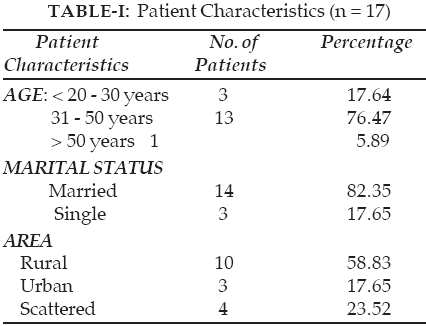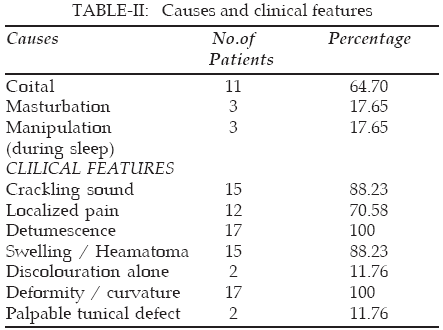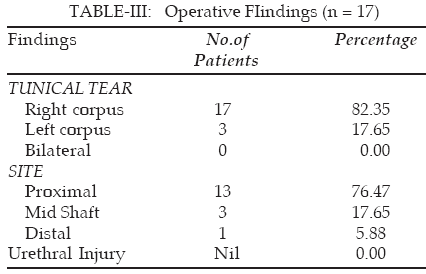|
|
||||
|
Published by : PROFESSIONAL MEDICAL PUBLICATIONS |
||||
|
ISSN 1681-715X |
||||
|
||||
|
- |
||||
|
ORIGINAL ARTICLE- |
||||
|
- |
||||
|
Volume 22 |
January March 2006 |
Number 1 |
||
|
|
||||
|
|
||||
|
|
||||
|
Published by : PROFESSIONAL MEDICAL PUBLICATIONS |
||||
|
ISSN 1681-715X |
||||
|
||||
|
- |
||||
|
ORIGINAL ARTICLE- |
||||
|
- |
||||
|
Volume 22 |
January March 2006 |
Number 1 |
||
|
|
||||
|
|
||||
Management of Penile fracture
Rooh-ul-Muqim1, Qutb-e-Alam Jan2 & Muhammad Zarin3
ABSTRACT:
Objective: To document the clinical presentations, diagnostic methods and therapeutic approach for the patients presenting with penile fracture and out comes of the treatment.
Design: Prospective observational study
Place and duration of study: Surgical ‘C’ and ‘B’ Ward of Khyber Teaching Hospital Peshawar, Pakistan, from January 2001 to December 2004.
Subjects and Methods: 17 patients presenting with fracture of the penis during this period were included in the study after approval from the Hospital Ethics’ Committee. Age, marital status, activity leading to the injury, symptoms and signs, management and outcome were recorded on a proforma designed for the purpose.
Results: The common age group was 30-50 years with 13 (76.47%) patients in this group, 14 were married and 3 were students. Eleven (64.70%) cases of fractures occurred during sexual intercourse and 6 cases due to non-coital causes including masturbation and manipulation. Fifteen patients recalled a popping sound, immediate detumescence and deviation were present in all, penile swelling and hematoma in 15 while the tunical defect was easily felt in 2 patients. Diagnosis was made clinically and was confirmed on surgical exploration. Repair of tunical defect was done with vicryle 2/0. No urethral injury was encountered. Out come was excellent and all patients regained complete penile function at 3 months follow up. Mild penile curvature was seen in 5 patients but it did not interfere with erection or sexual activity.
Conclusions: Penile fracture is an entity with typical clinical signs and no further investigations is usually needed. Management is surgical and immediate to avoid complications related to erectile dysfunction.
KEYWORDS: Penile fracture, Treatment, Outcome.
Pak J Med Sci January-March 2006 Vol. 22 No. 1 23-27
1. Dr. Rooh-ul-Muqim FCPS,
Assistant Professor of Surgery.
2. Dr. Qutb-e-Alam Jan FCPS, FRCS,
Senior Registrar
3. Dr. Muhammad Zarin FCPS,
Senior Registrar
1&3: Surgical C Unit, Khyber Teaching
Hospital,
Peshawar.
2: Surgical D Unit, Khyber Teaching Hospital,
Peshawar.
Correspondence:
Dr. Rooh-ul-Muqim
H.No.185, Street No.5, Sector J-2, Phase-II,
Hayatabad, Peshawar.
E-Mail: roohulmuqim@yahoo.com
* Received for Publication: July 19, 2005
Accepted: September 16, 2005
INTRODUCTION
Penile fracture is a relatively uncommon condition
1-2 and is a rare urological emergency.3 The true incidence is unknown. It has been reported as 1 of 175,000 hospital admissions,3 and in a review of 183 publications, 1331 cases were reported between January 1935 and July 2001, mostly from Mediterranean region.4Fracture of the penis is defined as the rupture of the tunica albuginea of corpora cavernosa, as a result of blunt trauma to the erect penis commonly during sexual intercourse or masturbation.
1,5 In the erect state the tunica thins from 2mm to 0.25mm and is more suspectible to traumatic tearing. Urethral injury with penile fracture is uncommon.6 The common causes are trauma to erect penis during coitus, masturbation and unconscious nocturnal penile manipulations or rolling over in bed.7,8 Suggestive clinical features are a popping or cracking sound with significant pain and immediate detumescence, swelling and bruising with a lateral deformity and hematoma are evident on examination.9 Urethral bleeding indicates an associated urethral injury.6Diagnosis is clinical and a "rolling sign", with the palpation of localized clot over the tunical tear site is pathognomic.
7,10 In doubtful cases cavernosograply, penile ultrasonography and even MRI have been used.7,11Treatment remains controversial but immediate surgical exploration and repair is widely accepted as therapy of choice in penile fracture and is superior to non-operational treatment.
1,8,12Recent observations of an apparent increase in the frequency of cases of penile fracture prompted us to study the clinical presentation, diagnosis and surgical approach together with inra-operative findings and post-operative complications in patients with penile fracture in our setup.
PATIENTS AND METHODS
This prospective study was carried out in the surgical C and Surgical B Units of Khyber Teaching Hospital Peshawar. The study was approved by the Hospital Ethics’ Committee. Between January 2001 and December 2004, all patients with penile fracture were included and an informed consent was obtained. Other penile injuries were excluded. Patient characteristics and details of clinical picture were recorded on a proforma by taking a detailed history including age, marital status, the activity leading to the injury, progress of symptoms until arriving in the hospital. Findings on physical examination like hematoma, deformity, swelling and discolouration were noted. The diagnosis was clinical and investigation like cavernosography was not needed. Baseline investigations like hemoglobin, random blood sugar, urinalysis and E.C.G were done in all patients as a requirement for general anesthesia.
A standard operative technique was adopted in all patients. The patients were catheterized. Artificial erection attained by injecting normal saline. A circumferential sub coronal incision was made followed by degloving the penis to its base. The hematoma was evacuated and the tunical tear identified. The tear was repaired with 2/0 vicryl taking interrupted stitches with inverted knots. The skin was closed with 2/0 catgut sutures. Drain was not kept. Pressure dressing was applied. Antibiotics were given to all patients pre-operatively and continued for 5 days post operative. Inj Cefuroxime Sodium was routinely used. Finally the length of hospital stay, post operative complications, progress of patients and follow up were also recorded.
RESULTS
During this period 17 cases with penile fracture were admitted and treated in our unit. All patients were admitted as emergency. The age of the patients ranged between 18 to 65 years with majority of patients in the 4
th decade i.e. 76.47%. Ten patients belonged to the rural and tribal areas, 7 to urban areas and of these three were university students. Among these 17 patients, 14 (82.35%) were married as shown in Table-I.

Table-II shows the causes and clinical features. Penile fracture was due to the sexual maneuvers in 11 (64.70%) cases. Other causes included masturbation and manipulation (i.e. manual and forcible deflection of erect penis commonly during sleep). 15 (88.23%) patients recalled a crackling sound while some localized pain was reported by 12 (70.58%) patients. Immediate detumescence was noted by all while a swelling and hematoma was seen in 15 (88.23%) and discolouration alone was present in 2 patients. Lateral curvature of the penis was present in all. None of the patient had voiding problem or signs of urethral injury.

The average time between injury to presentation was 9 hours (range 6 to 12 hours). All the cases were diagnosed clinically and specialized investigations like cavernosography or urethrography were not done in any patient. The surgery was performed in 6-8 hours of arrival.
Operative findings are depicted in Table-III. Tunical tear of the right corpus was common and found in 14 (82.35%) while tear on left side in 3 (17.65%) cases. In majority 13 (76.47%) the frature was proximal shaft. The tear in the tunica was unilateral and transverse in all cases while no urethral damage was noted.

The early post-operative course was unremarkable in all except wound infection in 1 (5.88%) despite prophylactic antibiotics. The catheter was removed after 48 hours and patients were discharged from the hospital 2-3 days after the operation. Follow-up on the average was 3 to 4 months. In the early post-operative period most of the patients had painful erection but at one month follow-up only 2 patients had painful erection, 5 had mild penile curvature and 7 had some fibrosis at the suture line. At 3 months no erectile dysfunction or pain on erection was reported by the 13 patients who reported for follow-up. The patients with penile curvature had no difficulty with intercourse and did not seek treatment.
DISCUSSION
Penile fracture though not a frequent event may have devastating anatomical, functional, psychological and social consequences. In our study majority of the patients were of 30-40 years of age and this is in accordance with the age range reported in literature,
7,9 however in a series of 34 penile fractures reported by Mydlo JH, the mean age was 27 years.13 The commonest causative incident is sexual intercourse, as the penis slips out of vagina and is thrust against the perineum or symphysis pubis.3 Eleven (64.7%) cases in our series also occurred during intercourse. Kochakarn W et al, reported 83% cases of penile fractures during intercourse and coital trauma to erect penis was the most common cause of fracture in other studies also.1,5,9,13,14 Others reported manipulation of erect penis to achieve detumescence as the common mechanism for penile fracture.7,15 In a study by Ekwere & Al Rashid 73.7% cases were due to non coital causes and more unmarried people.16 Masturbation and manipulation during sleep were responsible for 6 cases in our series while 14 (82.35%) were married and only 3 were unmarried university students.Penile fracture is an entity that generally has its diagnosis confirmed by its clinical presentation of sudden penile pain, detumescence, penile swelling hematoma and deviation accompanied often by a snapping or crackling sound.
4,9 All our cases had most of these diagnostic features and in 2 patients tunical defect was easily felt.The typical history and examination findings exempts performing complementary tests. Pre-operative cavernosography has been used by some authors to demonstrate the site of injury and to plan surgical approach
3,7,11,17 and it showed extravasations in 19 out of 21 cases in one study while the 2 patients with normal radiological findings had dorsal vein rupture.17 A significant incidence of false-negative findings exists and risks of tissue reaction to contrast material and increased corporal fibrosis also exists. Most authors now report using cavernosography in cases of doubt.11,17-18 All cases were diagnosed clinically and cavernosography was not needed in other studies.3,5,9 Ultrasonography can clearly visualize the penile fractures19 but we have no experience with it.Retrograde urethrography is indicated in penile fracture with suspected urethral rupture as evident by perurethral bleeding.
6 None of our patients had urethral injury and also urinalysis revealed no microscopic hematuria.All our cases were diagnosed clinically and diagnosis was confirmed upon exploration. Urethral injury is not common and has been reported as 10-20% and Mydlo JH reported 14.7% urethral injury.
13 Urethral injury is more likely with bilateral disruption of corpus cavernosum.20Immediate surgical intervention is the treatment of choice in penile fracture due to high risk of complications with conservative management.
12,14,20,21 All our patients were managed by early surgical intervention. The surgical approach is by sub coronal circumferential or dorsal incisions.3,9 We performed the sub coronal incision and degloved the penis to get sufficient area for reparation of tunica albuginea and any associated condition. It is the commonest type of operation used.9,13,16,22 In fact in a large series of 172 cases of penile fractures reported by Zargooshi J et al, circumferential incision was used with excellent long term outcome.15We preferred to expose the corpora cavernosa and repair any gap in the tunica albuginea which may be wider or irregular than suggested by physical examination.
All our patients were circumcised and it was more cosmetic to perform this incision. Surgical exploration revealed involvement of the right corpus in 14 (82.35%) and the fracture involving the proximal shaft in 13 cases. In one series of 11 patients, 8 of the cavernosal ruptures were on the right side and only 3 on the left.
3,23 In another small series of 7 patients by Gontero et al a complete pattern of different intraoperative findings including a completely transected urethra, a fracture at the base and rupture of the deep dorsal vein were encountered.24We inserted a urethral catheter pre-operatively as it helped in intraoperative dissection without harming the urethra and also fascilitated application of a pressure dressing, and preventing wound contamination as well. The insertion of pre-operative urethral catheter is however is controversial.
7 The catheter was removed after 48 hours and hospitalization period was 2-3 days.Complications: No immediate post-operative complication occurred except wound infection in one which healed by secondary intention resulting in mild fibrosis and curvature. Most patients had painful erection post operatively which subsided within a few weeks with no long term ill effects and only two patient had some erectile dysfunction which had improved at 4 month follow-up. In a series of 36 cases of immediate surgical repair follow-up at 1 year with detailed medical and sexual history, penile colour doppler USG, 6 had erectile dysfunction of vascular origin due to arterial and cavernous insufficiency.
20 Penile curvature was observed in 5 of our patients but they had no erectile or coital problem so they did not seek treatment for it.Post-operative suppression of spontaneous erections with diazepam or oestrogens is advocated by some authors while others believe that painful stimuli are sufficient control to prevent spontaneous erection and sedating effects of medication may be avoided.
7,23 We did not use it in our patients while anxiolytics were given in a few to relieve anxiety.CONCLUSIONS
Fracture of the penis is easily diagnosed by a proper history and physical examination. If there is doubt diagnosis can be confirmed by cavernosography.
Immediate primary surgical correction of penile fractures is successful in preserving normal erection with out significant complications. This treatment is associated with short hospital stay and rapid return of sexual function.
REFERENCES
1. Ishikawa T, Fujisawa M, Tamada H, et al. Fracture of the penis: nine cases with evaluation of reported cases in Japan. Int J Urol 2003; 10(5): 257-60.
2. Shah DK, Paul EM. et al. False fracture of the penis. Urology 2003; 61 (6): 1259.
3. Dincel C, Caskurlu T. et al. Fracture of the penis. Eastern Journal of Medicine 1998; 3(1): 17-9.
4. Eke N. Fracture of the penis. Br J Surg 2002; 89 (5): 555-65.
5. El-Taher AM, Aboul-Ella HA, et al. Management of penile fracture J Trauma 2004; 56(5): 1138-40.
6. Heng CT, Brooks AJ. Penile fracture with complete urethral rupture. Asian J Surg 2003; 26(2): 126-7.
7. Aman Z, Qayyum A, et al. Early surgical intervention in penile fracture. J Postgrad Med Inst 2004; 18(3): 432-8.
8. Gondal KM, Ali AA, Ranjah MA, et al. Management of penile trauma. Ann KE Med Coll 2001; 7(1): 47-9.
9. Kochakarn W, Viseshsindh V, Muangman V. Penile fracture: Long-term outcome of treatment. J Med Assoc Thai 2002; 85(2): 179-82.
10. Morris SB, Miller MA, Anson K. Management of penile fracture. J Roy Soc Med 1998; 91(8): 427-8.
11. Mydlo JH, Hayyeri M, Macchia RJ. Urothrography and caversonography imaging in a small series of penile fractures: a comparison with surgical findings. Urology 1998; 51(4): 616-9.
12. Muentener M, Suter S, Hauri D, Sulser T. Longterm experience with surgical and conservative treatment of penile fracture. J Urol 2004; 172(2): 576-9.
13. Mydlo JH. Surgeon experience with penile fracture. J Urol 2001; 166(2): 526-8.
14. Mydlo JH, Gershbein AB, Macchia RJ. Non-operative treatment of patients with presumed penile fracture. J Urol 2001; 165(2): 424-5.
15. Zargooshi J. Penile fracture in Kermanshah, Iran: report of 172 cases. J Urol 2000; 164(2): 364-6.
16. Ekwere PD, Al-Rashid M. Trends in the incidence, clinical presentation, and management of traumatic rupture of the corpus cavernosum. J Natl Med Assoc 2004; 96(2): 229-33.
17. Karadeniz T, Topsakal M, Aryman A. Penile fracture: Differential diagnosis, management and outcome. Brit J Urology 1996; 77(2): 279.
18. Fregany AF, Angermeier KW, Montague DK. Review of Cleveland clinic experience with penile fracture. Urology 1999; 54(2): 352-5.
19. Wilkins CJ, Sriprasad S, Sidhn PS. Colour Doppler ultrasound of the penis. Clin Radiol 2003; 58(7): 514-23.
20. Soylu A, Yilmaz U, Davarci M, Baydine C. Bilateral disruption of corpus cavernosum with complete urethral rupture. Int J Urol 2004; 11(9): 811-2.
21. Nane I, Tefekli A, Armagan A, et al. Penile vascular abnormalities observed long-term after surgical repair of penile fracture. Int J Urol 2004; 11(5): 316-20.
22. Ghanem AN. Penile fracture in Kermanshah, Iran: The long-term results of surgical treatment. Brit J Urology 2003; 91(3): 301-2.
23. Dincel C, Caskurlu T, Resim S. Fracture of the penis. Int Urol Nephrol 1998; 30(6): 761-5.
24. Gontero P, Muir GH, Frea B. Pathological findings of penile fractures and their surgical management. Urol Int 2003; 71(1): 77-82.
HOME | SEARCH | CURRENT ISSUE | PAST ISSUES
Professional
Medical Publications
Room No. 522, 5th Floor, Panorama Centre
Building No. 2, P.O. Box 8766, Saddar, Karachi - Pakistan.
Phones : 5688791, 5689285 Fax : 5689860
pjms@pjms.com.pk